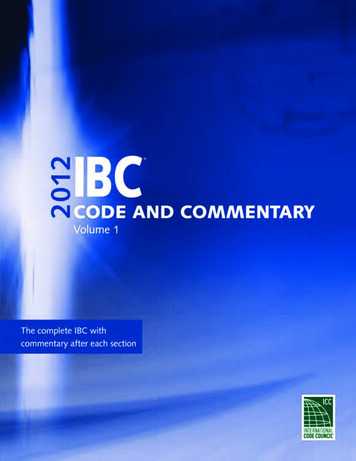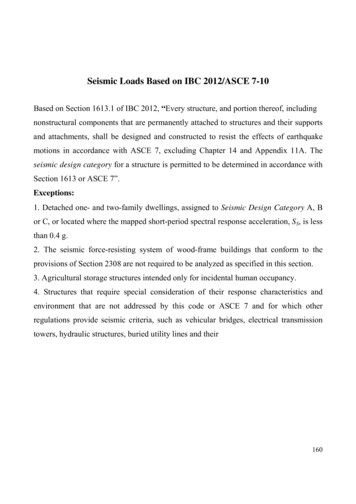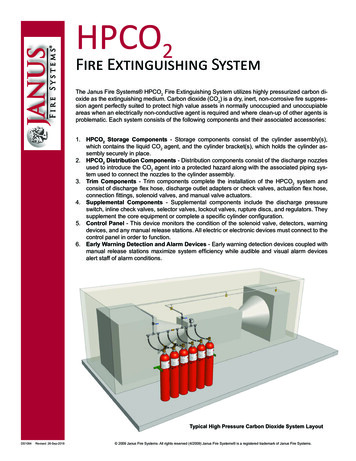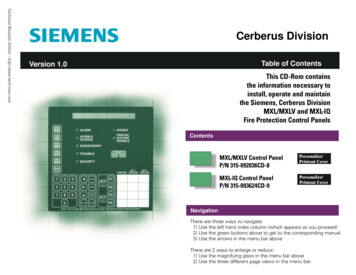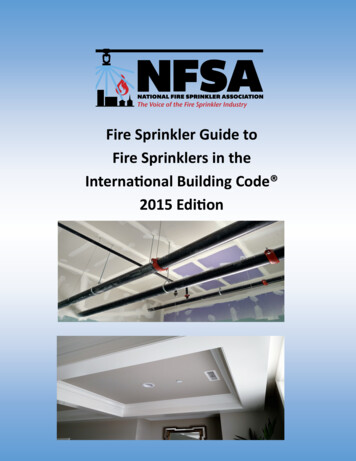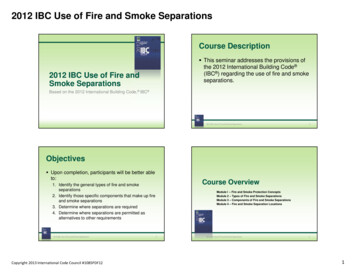
Transcription
2012 IBC Use of Fire and Smoke SeparationsCourse Description This seminar addresses the provisions ofthe 2012 International Building Code (IBC ) regarding the use of fire and smokeseparations.2012 IBC Use of Fire andSmoke SeparationsBased on the 2012 International Building Code, IBC 2012 IBC Use of Fire and Smoke Separations2Objectives Upon completion, participants will be better ableto:Course Overview1. Identify the general types of fire and smokeseparations2. Identify those specific components that make up fireand smoke separations3. Determine where separations are required4. Determine where separations are permitted asalternatives to other requirements2012 IBC Use of Fire and Smoke SeparationsCopyright 2013 International Code Council #1085PDF12Module I – Fire and Smoke Protection ConceptsModule 2 – Types of Fire and Smoke SeparationsModule 3 – Components of Fire and Smoke SeparationsModule 4 – Fire and Smoke Separation Locations32012 IBC Use of Fire and Smoke Separations41
2012 IBC Use of Fire and Smoke SeparationsConcepts of Fire and SmokeProtection IBC uses fire and smoke assemblies andprotectives for a variety of purposesModule 1 Fire and Smoke ProtectionConcepts2012 IBC Use of Fire and Smoke Separations5Structural integrityLimitation of fire spreadProtection of exitwaysRadiant heat exposureRestriction of smoke movement2012 IBC Use of Fire and Smoke SeparationsStructural IntegrityStructural Fire Resistance Under fire conditions, larger buildingsand/or buildings contain high-hazardoccupancies, selectively require specifiedlevels of fire-resistance for structuralmembers IBC Chapter 6 regulates structural integritythrough process of classification by “Typeof Construction” Structural fire-resistance is intended toprotect the structural integrity of buildingelements during fire conditions.Such elements include:2012 IBC Use of Fire and Smoke SeparationsCopyright 2013 International Code Council #1085PDF127 6Structural frame members.Bearing walls.Floor construction.Roof construction.2012 IBC Use of Fire and Smoke Separations82
2012 IBC Use of Fire and Smoke SeparationsLimitation of Fire SpreadProtection of Exitways Multiple conditions throughout the IBC utilizefire-resistive separations as a means to limitthe spread of fire. Complete fire or partial fire separations areeither mandated, or provided as analternative, to address a variety of issues. Vertical and/or horizontal separationstypically require opening protectives andother components to achieve full separation. As means of egress systems become morecomplex, fire-resistance-rated and/or smokeresistant construction is often mandated. The “exit” portion of the means of egress istypically where such protection must beafforded. Fire protection of exitways allows forextended travel in large area or multi-storybuildings.2012 IBC Use of Fire and Smoke Separations9 As a means to address the spread of firefrom building to building due to radiant heattransfer, fire-resistance-rated exterior wallsare required based upon proximity to lotlines and other buildings on the same site. Concept of “fire separation distance” appliedto regulate exterior wall fire-resistance andopening prohibition/protectionCopyright 2013 International Code Council #1085PDF1210Restriction of Smoke MovementRadiant Heat Exposure2012 IBC Use of Fire and Smoke Separations2012 IBC Use of Fire and Smoke Separations11 Various conditions are addressed in the IBCwhere the primary consideration is smokeresistance. Other conditions require a separation thatincludes both smoke-resistance and fireresistance Smoke-resistant construction is oftenmandated where occupants are incapable ofself-preservation and protect-in-placemethods are in place.2012 IBC Use of Fire and Smoke Separations123
2012 IBC Use of Fire and Smoke SeparationsFire-resistance-rated Separations There are a number of diverse types offire-resistance-rated separationsestablished in the IBC. Each unique type of separation serves adistinct purpose as reflected in the detailsapplicable to the wall or horizontalassembly.Module 2Types of Fire and SmokeSeparations2012 IBC Use of Fire and Smoke Separations132012 IBC Use of Fire and Smoke Separations14Fire-resistance-rated SeparationsFire Walls The following fire-resistance-ratedassemblies are selectively required by theIBC or can be provided as an alternative tocompliance: A fire wall is the most complex andprotective form of fire separation. Typically selected for use by the designerto provide an alternative solution, a firewall creates separate buildings in thesame structure. Fire walls are selectively required to be 2-,3- or 4-hour assemblies. Fire wallsFire barriersFire partitionsSmoke barriersExterior wallsHorizontal assemblies2012 IBC Use of Fire and Smoke SeparationsCopyright 2013 International Code Council #1085PDF12152012 IBC Use of Fire and Smoke Separations164
2012 IBC Use of Fire and Smoke SeparationsFire BarriersFire Partitions A fire barrier is the most common means ofseparating portions of a building. Used under both mandatory and optionalconditions, fire barriers divide a buildinginto separate areas for a variety ofpurposes where full separation is desired. Fire barriers are selectively required to be1-, 2-, 3- or 4-hour assemblies. A fire partition is required by the IBC wherea limited degree of fire and smokeprotection is warranted. The use of fire partitions is typical inlocations where separation is important inthe initial stages of building evacuation. Fire partitions are required to be minimum1-hour assemblies, with allowances for ½hour assemblies under specified conditions.2012 IBC Use of Fire and Smoke Separations172012 IBC Use of Fire and Smoke Separations18Smoke BarriersExterior Walls A smoke barrier is mandated where a highdegree of both fire and smoke protection isdesired. Smoke barriers typically are used to createrefuge compartments that allow occupantsto safely await assistance. Smoke barriers are required to be minimum1-hour assemblies while also providing ahigh degree of smoke resistance. Exterior walls provide separation from bothinternal fires and external fires. While commonly fire-resistance-rated dueto the wall’s proximity to a lot line, exteriorwalls also often provide for the protection ofoutdoor exit travel. Exterior walls are selectively required to beminimum 1-, 2- or 3-hour fire-resistancerated assemblies.2012 IBC Use of Fire and Smoke SeparationsCopyright 2013 International Code Council #1085PDF12192012 IBC Use of Fire and Smoke Separations205
2012 IBC Use of Fire and Smoke SeparationsHorizontal AssembliesSmoke-resistant Separations Horizontal assemblies are typically usedtogether with fire-resistance-rated wallassemblies to provide completecompartmentation in multi-story buildings. In most cases, the ceiling and floor worktogether, as well as independently, toprovide the intended separation. Horizontal assemblies are selectivelyrequired to be minimum ½-, 1-, 2-, 3-, or 4hour fire-resistance-rated assemblies. In addition to the use of smoke barriers, theIBC also recognizes smoke partitions as ameans to resist the passage of smoke. Smoke partitions are required in thoselocations the movement of smoke is aconcern, however fire is not aconsideration. Smoke partitions are not required to have afire-resistance rating.2012 IBC Use of Fire and Smoke Separations212012 IBC Use of Fire and Smoke Separations22Prescriptive Separations Prescriptive separations are also mandatedin those cases where a limited degree ofseparation is desired Although not required to be a tested andlisted assembly, these separation elementsadequately serve a specific need, including: Gypsum board Wired glass Non-rated floor construction Construction capable of restricting smoke transfer2012 IBC Use of Fire and Smoke SeparationsCopyright 2013 International Code Council #1085PDF1223Module 3Components of Fire andSmoke Separations2012 IBC Use of Fire and Smoke Separations246
2012 IBC Use of Fire and Smoke SeparationsVertical ElementsVertical Elements A variety of different walls and partitionassemblies are established in the IBC toprovided varying degrees of fire and/orsmoke separation. In addition to vertical assemblies that aretested and listed as fire-resistance-rated,modified assemblies and prescriptivebased separation elements are selectivelyaddressed throughout the code. Wall assemblies such as fire walls, firebarriers, fire partitions, smoke barriers andexterior walls must be provided with fireresistance ratings as determined inaccordance with ASTM E119 or UL 263. The required fire-resistance ratings varythroughout the IBC and are selectivelyidentified based upon the intended purposeof the vertical separation.2012 IBC Use of Fire and Smoke Separations252012 IBC Use of Fire and Smoke Separations26Vertical ElementsHorizontal Elements Partial assemblies based on listedassemblies are also recognized in limitedapplications, typically where the potentialhazard is assumed to exist only on oneside of the separation element. Prescriptive separation elements are alsooccasionally mandated, where a specificmaterial is identified as the minimum levelof separation required. Horizontal assemblies are also tested andlisted assemblies that resist the spread offire vertically. Fire-resistance-rated floors andfloor/ceiling assemblies can providevarying degrees of fire-resistance. Non-rated horizontal elements also providea significant level of separation and areregulated under a variety of conditions.2012 IBC Use of Fire and Smoke SeparationsCopyright 2013 International Code Council #1085PDF12272012 IBC Use of Fire and Smoke Separations287
2012 IBC Use of Fire and Smoke SeparationsDoorsVertical/Horizontal Combination In many cases, the IBC uses both verticaland horizontal elements in order tocompletely separate one area fromanother. The use of multiple elements allows for acomplete separation that will restrict thespread of fire, smoke and gasses from thearea of fire origin.2012 IBC Use of Fire and Smoke Separations29Doors For example, a solid-wood or honeycombsteel door of a specified thickness might beestablished as the minimum required door. At times, the code does not regulate doorassemblies in a fire separation element. The most common example is where fireresistance-rated exterior walls are locatedwhere opening protection is not required.Copyright 2013 International Code Council #1085PDF122012 IBC Use of Fire and Smoke Separations30Windows In a few cases, a prescriptive means ofdoor protection is mandated.2012 IBC Use of Fire and Smoke Separations Typically, doors require protection as partof the overall package of fire and/or smokeprotection. In most cases, door assemblies requiring afire-protection rating are mandated in fireseparation assemblies. Although Table 716.5 provides the requiredratings and markings for most conditions,in some cases they are also individuallyidentified based on the specific separation.31 Windows are typically regulated in thesame manner as doors. In addition to fire-protection-rated glazing,fire-resistance-rated glazing is alsoaddressed. Fire-resistance-rated glazing is regulated inmuch the same manner as fire-resistancerated wall assemblies.2012 IBC Use of Fire and Smoke Separations328
2012 IBC Use of Fire and Smoke SeparationsWindowsPenetrations and Joints There are situations in the code wherenonrated glazing is permitted in separationwalls, such as where security glazing isneeded, where smoke is the only concern,or where fire-resistance-rated exteriorwalls are permitted with unprotectedopenings. Penetrations of separation elements musttypically be protected by firestop systemsrated to the same level as the elementpenetrated. Prescriptive methods of penetrationprotection are also established. Fire-resistant joint systems are mandatedwhere joints occur in separation wallsrequiring opening protection.2012 IBC Use of Fire and Smoke Separations332012 IBC Use of Fire and Smoke Separations34Air Movement Fire dampers, smoke dampers,combination dampers and ceiling radiationdampers are selectively required in ductsand air openings in separation elements. Dampers may be omitted in a variety ofsituations where their use has beendetermined to be unnecessary.2012 IBC Use of Fire and Smoke SeparationsCopyright 2013 International Code Council #1085PDF1235Module 4Fire and Smoke SeparationLocations2012 IBC Use of Fire and Smoke Separations369
2012 IBC Use of Fire and Smoke SeparationsSeparation Locations Building Size, Use and ComponentsExitwaysFire Protection FeaturesSpecial Building TypesSpecial Occupancies and UsesSpecial Building FeaturesHazardous Uses2012 IBC Use of Fire and Smoke SeparationsBuilding Size, Useand Components37Building Height and AreaSection 503.12012 IBC Use of Fire and Smoke Separations38Building Height and AreaSection 503.1 Each portion of a building separated by afire wall shall be considered a separatebuilding. The use of a fire wall is selectivelydetermined by the designer as a means toreduce building size, thus increasing theavailable types of construction.2012 IBC Use of Fire and Smoke SeparationsCopyright 2013 International Code Council #1085PDF12392012 IBC Use of Fire and Smoke Separations4010
2012 IBC Use of Fire and Smoke SeparationsFire Wall Fire-resistance RatingsTable 706.4Fire Walls The required minimum rating of a fire wall isbased on the buildings’ type(s) ofconstruction and occupancy classification(s). The use of a fire wall also provides a varietyof other alternative solutions to thedesigner, such as: Multiple types of construction Reduction/elimination of fire protection features Fire walls are also selectively required byother provisions of the code.2012 IBC Use of Fire and Smoke Separations41Separated OccupanciesSection 508.4.4.12012 IBC Use of Fire and Smoke Separations42Separated OccupanciesTable 508.4 In a mixed-
2012 IBC Use of Fire and Smoke Separations 26 Vertical Elements Partial assemblies based on listed assemblies are also recognized in limited applications, typically where the potential hazard is assumed to exist only on one side of the separation element. Prescriptive separation elements are also occasionally mandated, where a specific material is identified as the minimum level of separation .File Size: 2MBPage Count: 42
